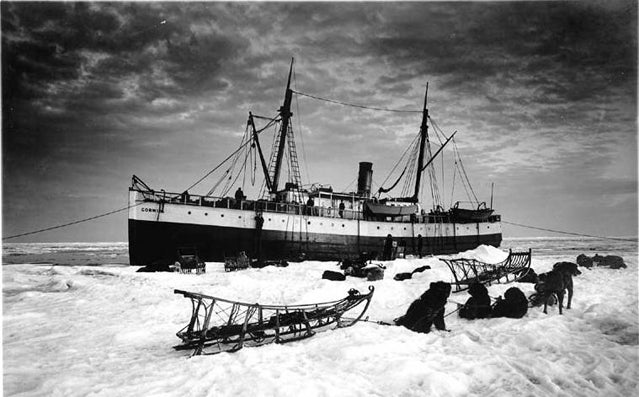
Corwin, in which John Muir sailed as part of an Arctic research trip. Photo:
In
July 1879, 33 Navy men set sail for the North Pole aboard the U.S.S. Jeannette Arctic
expedition. That fall the ship became mired in ice off southern Alaska and drifted
for three years. Its hull was later crushed and the crew abandoned the ship,
pulling smaller crafts over the ice, searching for open water. In the end, only
11 men survived. But the logbook, in which the ship's crew wrote detailed
weather and sea ice observations, also survived.
Climate scientists are hoping the data inside that and many other Naval and
Coast Guard ships, dating back to the mid 1800s, will improve climate science
and boost the accuracy of modeling for future weather patterns. Last year, the National
Oceanic and Atmospheric Administration (NOAA) and the National Archives and
Records Administration (NARA) began digitizing these logbooks. Now,
, a collaboration between a number of
academic, government and citizen science research organizations, is spearheading the Arctic Rediscovery Project, an effort to transcribe this
massive amount of data, a vital first step in the data analysis process.
Last
month, sea ice covering the Arctic Ocean fell to the lowest extent in the
existing records, which extend back to 1979, when satellite-based data first
became available. This was an alarming discovery, especially given the absence
of extreme weather that has precipitated ice loss in years past. But the Arctic
Rediscovery Project could greatly improve climate scientists' understanding of
Arctic sea ice by extending the archives of scientific sea ice data by
more than 100 years.
Once
collected, the data will represent “a marked incremental improvement to
what we know about Arctic ice and that will really change what we can say about
the future,” says Kevin Wood, a research scientist at NOAA's Joint
Institute for the Study of the Atmosphere and Ocean at the University of
Washington. “I would not say it's going have a major impact, but you never
know.”
The
weather data from each logbook, which includes temperature, barometric
pressure and other variables such as wind, cloud cover and wave action, will
go into a database and used for retrospective analysis. This, explains Wood,
will allow climate scientists to sample data as far back as possible and then
“reconstruct the atmosphere in the Arctic for every six hours, from 1850
until now.”
Here's a video from Old Weather about how weather data is used to reconstruct climate maps:
In fact, on the Old Weather Vimeo page are pretty fascinating.
OTHER
VALUE
The
logbooks will do more than let climate scientists tap into more of the Arctic's
recent history, they will also likely provide valuable insights for historians,
biologists and a long list of other interested parties.
“The
National Archive is excited because we will be posting copies of the logbooks
to our website, so anyone who has access to the Internet will be able to look at
these pages,” says Mark Mollan, a Navy/Maritime reference archivist with
NARA.
Each
logbook follows a generally standard format, with weather data on one side and
the facing page used for observations. “Sometimes there are multi-page
reports that detail on overland rescue operation,” says Mollan. “We
found some actual flowers tucked into a logbook from 1891. We're now trying to
identify them with DNA analysis.”
The
spread of sickness among crewmembers would also be documented, which can be
valuable for epidemiologists tracking the history of specific ailments.
The
team also hopes to scan logbooks from the and the
Providence Public Library, notes Wood, who says whale ship logbooks also offer
clues into the historical pressures placed on specific fisheries. “As I
read through these old whaling logbooks I came across one from 1854. The crew
was near Kamchatka and they could see 50 whaling ships, all trying to kill
Bowhead [whales]. So, pressure on that fishery might be even worse than we
thought.”
YOU
CAN HELP
In
addition to Navy and Coast Guard logbooks, those belonging to the ships of the
Revenue-Marine fleet, an old maritime law enforcement agency, are being
digitized. This includes that of the Revenue Cutter Thomas Corwin, in which
John Muir sailed as part of an Arctic scientific research trip in 1881.
It's
hard to imagine how exciting and terrifying (not to mention, long, cold and
tedious) these expeditions were. The crews were isolated for months or years
and had no means for two-way communication. But as a volunteer, you can help
climate scientists unlock the knowledge that the logbooks hold.
OldWeather.org
and citizen science service are recruiting citizen scientists to help transcribe the digitized pages. It's
a huge job—each page is transcribed by three individuals in order to ensure
accuracy—but the sooner it's
done, the closer climate scientists will be to unlocking the value the logbooks
hold and improving climate science. You can get started at the
website.
But first, check out this short video that overlays recordings of Arctic sea ice movements atop images and narration from Arctic explorers:
��ⲹ����
Catherine O'Connor